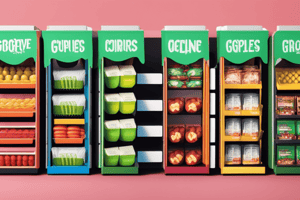Podcast
Questions and Answers
What is the main purpose of making a list before going grocery shopping?
What is the main purpose of making a list before going grocery shopping?
- To ensure you don't forget what to buy (correct)
- To save time on the shopping trip
- To avoid the need for impulse buying
- To impress other shoppers with your organization
Which section in a grocery store would you visit to find milk and cheese?
Which section in a grocery store would you visit to find milk and cheese?
- Ethnic or imported food section
- Dairy section (correct)
- Frozen food section
- Produce section
What distinguishes grocery shopping from regular shopping?
What distinguishes grocery shopping from regular shopping?
- The focus on buying food items (correct)
- The availability of bulk food items
- The long, narrow aisles
- The need for a membership fee
Where can you find non-perishable food items like tuna and spaghetti sauce in a grocery store?
Where can you find non-perishable food items like tuna and spaghetti sauce in a grocery store?
What is a common use of the dry goods aisles in a grocery store?
What is a common use of the dry goods aisles in a grocery store?
Which type of grocery store requires customers to pay an annual membership fee?
Which type of grocery store requires customers to pay an annual membership fee?
What are aisles in a grocery store primarily used for?
What are aisles in a grocery store primarily used for?
What section of the grocery store would likely sell laundry detergent and deodorant?
What section of the grocery store would likely sell laundry detergent and deodorant?
Where can customers find pre-cooked food items like pizza and sandwiches?
Where can customers find pre-cooked food items like pizza and sandwiches?
What is the modern option for customers to check out their items themselves at a grocery store?
What is the modern option for customers to check out their items themselves at a grocery store?
What is discouraged in Canada with reusable bags being the alternative?
What is discouraged in Canada with reusable bags being the alternative?
What are grocery store workers commonly called?
What are grocery store workers commonly called?
Where do customers pay for their items at the grocery store?
Where do customers pay for their items at the grocery store?
What are the different methods used for paying groceries at the checkout?
What are the different methods used for paying groceries at the checkout?
Where should customers return their shopping carts after shopping?
Where should customers return their shopping carts after shopping?
Flashcards are hidden until you start studying
Study Notes
- The text is about grocery shopping and the experience of visiting a grocery store.
- Grocery stores or supermarkets are places where people buy food.
- In North America, there are larger stores called warehouse clubs or wholesale clubs where customers pay an annual membership fee for larger stores and bulk food items.
- The two most popular warehouse clubs are Costco and Sam's Club.
- Grocery shopping is a specific term for buying food, distinguishing it from regular shopping.
- Making a list before going grocery shopping is important.
- Phrases used to indicate the need for grocery shopping include "need to get groceries," "need to run to the grocery store," and "have to do some grocery shopping."
- Aisles are long, narrow passages in grocery stores used to access different kinds of food and products.
- There are various sections within grocery stores, such as the produce section for fruits and vegetables, the frozen food section for frozen foods, the bakery section for fresh-baked goods, and the dairy section for milk and cheese.
- Ethnic or imported food sections are also common in grocery stores.
- Canned food sections are where non-perishable food items like tuna, beans, and spaghetti sauce are sold.
- Bakery sections sell items used for baking, such as flour, sugar, and candies.
- Dry goods aisles contain items like pasta and rice.
- Bulk food sections allow customers to buy food in larger quantities and pay by weight.
- Snack aisles offer a variety of snack foods like chips, pretzels, and salsa.
- Beverage aisles sell various beverages like soda or pop, cola, or beer, wine, and spirits.
- Household items sections sell products like laundry detergent, deodorant, shampoo, and other household supplies.
- Hot food counters offer pre-cooked food items like pizza, sandwiches, and hamburgers.
- Workers at grocery stores can be called cashiers or workers.
- Common questions asked at grocery stores include "in which aisle can I find...?"
- Checkout areas are where customers pay for their items.
- Self-checkout is a more modern option for customers to check out their items themselves.
- Express checkouts are for customers with fewer items to purchase.
- Payment methods include cash, debit cards, credit cards, interact cards, and rewards cards like Air Miles or Aeroplan.
- Customers receive a receipt after completing their purchase.- A person went shopping for tomatoes and iceberg lettuce at a grocery store.
- At the end of the checkout, a bagger assists in putting purchases into grocery bags (some stores have self-service bagging).
- Using plastic bags is discouraged in Canada and reusable bags are an alternative.
- Upon leaving the store, groceries are loaded into a vehicle.
- Customers are expected to return their shopping carts to the designated area.
- At home, groceries are unloaded from the vehicle and put away in various storage areas, such as cupboards, fridge, and freezer.
Studying That Suits You
Use AI to generate personalized quizzes and flashcards to suit your learning preferences.





